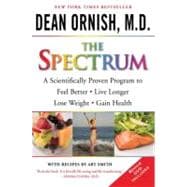
Note: Supplemental materials are not guaranteed with Rental or Used book purchases.
Purchase Benefits
What is included with this book?
| Foreword | p. xi |
| Welcome: How to Personalize a Way of Eating and Living Just Right for You | p. 1 |
| It Works! | p. 3 |
| Why It Works | p. 23 |
| How It Works | p. 40 |
| You Are Unique | p. 76 |
| The Nutrition Spectrum | p. 90 |
| The Stress-Management Spectrum | p. 115 |
| Guided Meditations | p. 132 |
| The Exercise Spectrum | p. 141 |
| Lowering Your Cholesterol Level Using the Spectrum | p. 154 |
| Losing Weight Using the Spectrum | p. 164 |
| Lowering Your Blood Pressure Using the Spectrum | p. 178 |
| Preventing and Reversing Type 2 Diabetes Using the Spectrum | p. 187 |
| Preventing and Reversing Cardiovascular Disease Using the Spectrum | p. 199 |
| Preventing and Treating Prostate Cancer and Breast Cancer Using the Spectrum | p. 219 |
| Welcome to Art's Kitchen: An Abundant Spectrum of Foods to Enjoy | p. 237 |
| A Note by Art Smith | p. 239 |
| Recipes | p. 241 |
| Breakfast | p. 245 |
| Lunch | p. 253 |
| Dinner | p. 270 |
| Sides, Sauces, and Snacks | p. 298 |
| Desserts | p. 307 |
| Essential Kitchen Tools for Low-Fat Cooking | p. 315 |
| Cooking Lessons | p. 319 |
| Shopping and the Home Pantry | p. 330 |
| Healthful Ingredients to Stock Your Kitchen With | p. 332 |
| Produce Seasonality Guide | p. 335 |
| Art's Pantry and Kitchen Equipment Sources | p. 339 |
| Epilogue | p. 341 |
| Acknowledgments | p. 343 |
| References | p. 349 |
| Index | p. 371 |
| Table of Contents provided by Ingram. All Rights Reserved. |
The New copy of this book will include any supplemental materials advertised. Please check the title of the book to determine if it should include any access cards, study guides, lab manuals, CDs, etc.
The Used, Rental and eBook copies of this book are not guaranteed to include any supplemental materials. Typically, only the book itself is included. This is true even if the title states it includes any access cards, study guides, lab manuals, CDs, etc.
Excerpted from The Spectrum: A Scientifically Proven Program to Feel Better, Live Longer, Lose Weight, and Gain Health by Dean Ornish
All rights reserved by the original copyright owners. Excerpts are provided for display purposes only and may not be reproduced, reprinted or distributed without the written permission of the publisher.